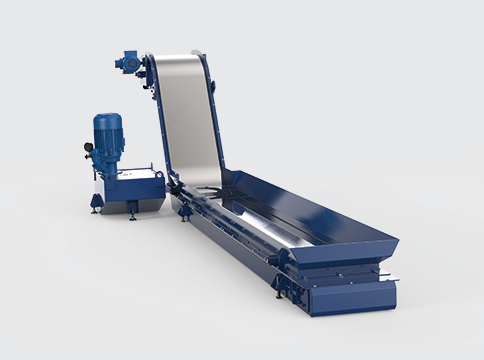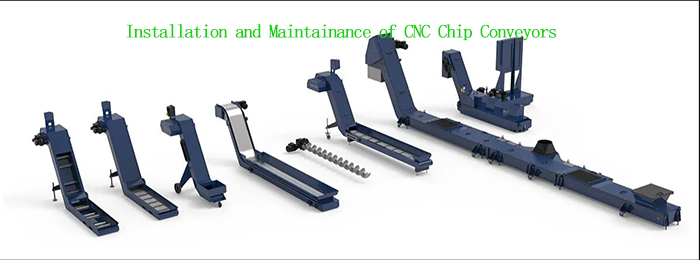In the present world, we live in the era of modern manufacturing. In this era, computer numerical control (CNC) machines have become the backbone of manufacturing in many industries, providing much more precision and accuracy during various operations. These advanced machines have entirely changed the way how products are manufactured. These machines have enabled manufacturers to make complex designs and geometries with high accuracy and precision.
But, besides all these technological advancements, there are still some challenges that manufacturers should address: the management of chips and swarf generated during machining processes. The accumulation of these chips can stop the operations, cause the machine to wear, and even cause downtime. To overcome this challenge, chip conveyors ensure the seamless flow of manufacturing processes by efficiently handling the debris produced during machining.
In this article, we will look at the application of chip conveyors and their benefits in CNC machines. We will see how they are crucial in optimizing the manufacturing processes. We will discuss the fundamentals of chip conveyors, their wide range of applications, and the factors that impact their selection. We'll also talk about how essential maintenance and installation are. By the end of this article, you will understand how chip conveyors play a crucial role in effective CNC machining, improved tool performance, automation, and overall manufacturing productivity.

Inside a CNC machine, a lot of leftover material (chips and dust, etc.) is created when the machine functions. If these leftovers are correctly handled, the machine can avoid several issues. For this reason, some kind of bulk metal collection mechanism is necessary to eliminate metal chips and other residual material generated during production. Chip conveyors play a vital role here by removing the chips produced by cutting tools in the CNC machining process.
There are many applications of chip conveyors in CNC machines, such as:

The main application of chip conveyors is effectively removing chips from the machining area. When the fragments accumulate, they can affect the machining process and reduce the accuracy of the cutting tool and the machine's performance. Chip conveyors prevent this from happening by continuously removing the chips from the machining zone. It helps to maintain the accuracy and quality of the finished product. It also eliminates the need for manual chip removal and ultimately reduces machine downtime.
Chips and other residual materials produced during the machining can interfere with the manufacturing process causing poor surface finishes and increased wear on the cutting tools. By efficiently removing the chips from the machining area, chip conveyors ensure that cutting tools maintain their effectiveness for more extended periods, improving surface quality and longer machine life. It is also cost-saving because it reduces the tool changing frequency.
When the chip conveyors are integrated with automated manufacturing systems, productivity is increased considerably. As a result, the CNC machines will be able to work continuously without any manual interference for a longer time without any worry about the chip and residue removal. As a result, production efficiency increases, and operators can focus on value-added tasks.
Proper management of chips is not only beneficial for the machine but also for the maintenance of a safe and clean environment. If the chips are accumulated on the machine, they pose safety hazards to the operators and can also decrease the efficiency of the workplace. When the fragments are collected and disposed of properly with the help of chip conveyors, workplace hazards are minimized, and all the above issues are addressed. To sum it up, proper chip management promotes sustainable environmental and safety practices.
There are many different chip conveyor types used in manufacturing; a few of them are discussed below:
Hingle belt conveyors are one of the most popular and widely used chip conveyors. They are primarily included in the new CNC machine purchases. They are much more affordable and reliable if they are correctly matched with specific machining applications, like collecting coarse and stringy stuff. There are several types of belts, each of which comprises interconnected metal plates forming a moving belt. As a result of these conveyors, chips are efficiently transported away from the machining area, ensuring smooth operations and preventing chip accumulations that could lead to disruption or decreased accuracy. The downside is that there are better choices than this if you're making aluminum, brass, cast iron, or other fine chips because they can clog the conveyor and coolant lines.

Designed for heavy-duty chip handling, scraper conveyors are the perfect choice for processing processes that generate substantial amounts of chips and swarf due to the machining operation. In these types of conveyors, chips are collected and moved along the conveyor path using a scraper mechanism. With their robust design, they can efficiently remove chips, thus reducing the risk of machine downtime caused by chip buildup on the surface.

A magnetic chip conveyor is perfect for ferrous-only machining processes that produce splinters on the chip while the chip is being processed. To move ferrous chips, magnetic chip conveyors utilize strong magnets that are used to attract and transport ferrous chips, so it is an excellent solution for situations where ferrous chips need to be separated from other materials like coolant, and they are magnetic. However, if the process creates stringy material that is longer than the distance between each of the conveyor magnets, these long strings might cause a short in the magnets.

When it comes to dealing with the leftover bits in machines that shape things, pivot belt conveyors are really handy. They let the belt move around, so you can change where the leftover bits come out. This makes things work better when removing those bits and helps the machine work better too. So, using these conveyors enables you to control where the leftover bits go, making better stuff and smoother things.
There's this kind of conveyor called drag chain conveyors, and they're really good for carrying around those heavier and bigger leftover bits in places where things are made. These conveyors use a chain to move those bits, which is great when transferring them over big distances. What's remarkable is that they make sure the bits are always taken away, so the machines can keep doing their job well. These conveyors are smart for moving leftover bits around in factories because they're dependable and do the job efficiently.
A spiral conveyor is handy for dealing with long and short leftover bits from CNC machines. It's cool because it makes those leftover bits take up less space, which makes the machines work better and also saves money on the stuff they use to cut things. And what's neat is that it's made to fit into small spaces but still works really well. This conveyor can be adjusted to fit different machines, which makes it a smart choice that doesn't cost too much. Plus, it has a safety feature to ensure it doesn't get overloaded. So, in the end, this spiral conveyor is a clever way to deal with leftover bits in factories. It helps things run smoother, saves money, and is good for the environment too.
Many factors can affect the selection of a Chip Conveyor for a CNC machine. These factors determine the effectiveness and compatibility of the cnc chip conveyors. Some of these factors are:
In the era of CNC machining, there are various types of machines, each having a unique set of capabilities with different chip generation rates and special limitations. The type and size of the machine play a crucial role in determining the best-suited chip conveyor design. The little conveyors work differently from the big ones when dealing with milling machines. This is because they make smaller leftover bits and have less room to work with.
The material being manufactured by the machine plays a significant role in determining what type of chip conveyor would be suitable for the machine. Different material has different characteristics, such as hardness, size, shape, etc. So the type of chip conveyor may vary depending on the features of the material. It's important to pick a conveyor that's really good at dealing with the exact leftover bits made by the material. This ensures that taking away those bits goes smoothly and without problems.
When choosing the right conveyor, the amount of leftover bits made when shaping things is significant. Whether there are a lot of small leftover bits or just a few big ones, the conveyor needs to be able to handle them properly. This means the conveyor's size and how it's made should match the kind of leftover bits so that they can be moved around without any issues.
In factories, how things are arranged is important when choosing a conveyor system. The space available, how close it is to the CNC machines, and the overall layout of the place all matter for the conveyor to work well. So, it's crucial to plan where things go carefully, so the conveyor system can do its job smoothly and not cause problems for other tasks.
A good plan for where things are placed is necessary for the conveyor system to work well. It helps remove leftover bits properly, keeping the place clean and safe. Also, the plan ensures the conveyor system stays in the way of other work happening, which is needed for everything to go smoothly.
When picking chip conveyors, there are different types, and each needs maintenance. So, it's important to consider how well your factory can care for them. Choosing a conveyor that matches what you can maintain will work well for a long time and will avoid problems. Choosing the suitable conveyor for your factory helps everything run smoothly and succeed.
When you consider all these things that affect it, manufacturers can choose which chip conveyor to pick. This helps them better manage leftover bits and ensures the CNC machines work well in the factory.
It is essential to properly install and maintain the chip conveyors if you want them to perform in the long run. Below is some vital information that will help establish and maintain the CNC chip conveyors.

When you are installing a chip conveyor, there are some steps that you must keep in mind to make sure that it is appropriately integrated with the CNC machine.
It is essential to properly align the CNC conveyor with the CNC machine to ensure that chips are transferred smoothly. An improper alignment can lead to issues like machine jamming, improper chip flow, etc. When everything is aligned perfectly, all the leftover bits are removed without any problems from the production area.
Different CNC machines have coolant systems that help optimize the machining process. When you install a chip conveyor, it is necessary to ensure it is connected well to a coolant system. Doing this ensures the leftover bits are removed without messing up the coolant's movement. The coolant is super essential for keeping the tools sharp and providing the things being shaped turn out well.
Cleaning the conveyor helps stop leftover bits from piling up and causing jams. Removing collected debris makes sure the conveyor keeps working smoothly. Taking away chips on time also keeps the workplace safe.
Putting lubrication on moving parts, like bearings and rollers, stops them from rubbing too much and wearing out. Regularly checking these parts is vital to catch any damage or wear out. Fixing problems quickly makes the conveyor last longer and avoids sudden breakdowns.
In the fast-paced world of CNC machining, chip conveyors are essential partners that help everything run well. They tackle the challenges of dealing with leftover bits and ensure the machines work better, get more done, and keep the workplace safe. As CNC machines improve, chip conveyors will become even more critical in shaping how things are made. This will let manufacturers make things more accurately, with better quality, and in a way that's good for the environment.